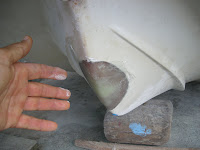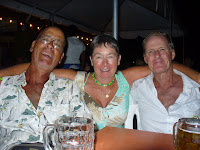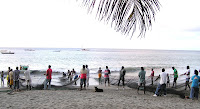At the Charlotteville anchorage most of our needs can be met within a short walk from the dinghy dock. Diesel fuel is available on some days to jerry jug to boat. There is an internet café, public library, bakery (coconut bread!), laundry and at least 7 beach-front bars. Local-made ice cream comes in coconut, peanut and rum raisin. There are several small groceries on the waterfront for canned staples, dry goods, New Zealand cheese and Irish butter. Locally grown produce at the small stall includes avocado, yams, pumpkin, callaloo (dasheen), tyme, pineapple, paw paw, bananas, breadfruit, cassava (tapioca), endo, coconut, cabbage, simba peas and mango. The several restaurants have interesting local cuisine (catherine is pictured with Buss Up Shut, dhalpourri and a Roti). The restaurants have clay ovens.
The local fishing fleet of about 30 pirouges have unique names including “come test meh”, “jah rule”, and “inez pride”. When not is use, the pirouges are moored off the beach, fishermen swim out. The fish catch is off-loaded from the beach through the surf.
There are two basic fishing techniques; trolling hand lines for Wahoo (locally called Kingfish) and Tuna, or fish traps for reef fish (small snapper) and lobster (rare). Size and catch limits get lip service only. At least the Wahoo fishery seems secure since the abundant catch is all of large fish (1.5-1.8 m). The fish we purchase within minutes of their landing have been super. Catherine has greatly expanded her list of sauces and marinades for BBQ fish.
We swim almost every day. The weather is wonderful. There are brief showers almost every day; almost enough to keep our water tanks full (we use our watermaker about 5 hrs per week). Daily temperature range is 25-30 deg C (77-86 deg F). Humidity about 75%.
We made one day trip to Scarborough because the local ATM does not accept our cards and we wanted a few grocery items not available locally. The 3 hour round trip in new buses is economically priced at Canadian $2.70 per person. Scarborough (pictured below) is a much larger city. Very colourful, but also noisy and crowded for us.
We made one day trip to Scarborough because the local ATM does not accept our cards and we wanted a few grocery items not available locally. The 3 hour round trip in new buses is economically priced at Canadian $2.70 per person. Scarborough (pictured below) is a much larger city. Very colourful, but also noisy and crowded for us.
We have encountered many interesting people here, both residents and visitors. Bee rides Junie his donkey to tend the cattle he has tethered here and there in the forest. Dougie runs a bar and restaurant and put on a great “Old Years Night” party last year, so we expect the same this year.
Bamboo cannons are a common entertainment of young boys. A few ml of Kerosene is poured onto smouldering coals in the lower end of the cannon, heated there by blowing through a slit to vaporize it, and then “touched off” with a flame transferred from the wink burning in the beer bottle. The result is a satisfying explosion of flame and smoke which hopefully spares the eyebrows of the operator!

We were pleased to meet a couple who just opened a small café after living here for 14 years (“I’m not from the US, I’m from New York City”). Catherine is pictured below on the deck of their café overlooking the “Charlotte D” at anchor.
There are only a few cruising sailboats here at any one time. Most are making their Caribbean landfall after crossing the Atlantic from the Cape Verde Islands. A Danish sailor solo aboard his 7.6 m sloop previously completed a solo circumnavigation of the Atlantic basin and is now on his way to the Pacific, planning to bicycle New Zealand and Australia. A British sailor left England 15 years ago aboard his 10 m sloop and has one more day’s sail to cross his outbound track and so complete his leisurely circumnavigation of the globe. He has sailed with at least 2 wives and several girlfriends, and is now solo. He is planning an air trip to England because of family concern that his parents “are about to fall off their perch”. A Finnish sailor left his homeland 22 years ago, has completed several circumnavigations, and is now into another with his Thai wife who he met on an earlier circuit. They plan to continue round and round “as long as we can hoist a sail”. Finally, a Swedish couple have completed half of their circumnavigation of the Atlantic basin in their engine-less 9m sloop, and plan to sail back to Sweden before the next hurricane season.
You can imagine the interesting conversations with these world travelers! Plenty of bragging and lying, for sure. But their accomplishments do attest to their competence . We can vouch personally for their abilities at drinking beer and rum!
The village spreads part way up the surrounding hills. The Tobago rain forest begins just beyond the last homes and offers some lovely but strenuous walking.



Catherine is keeping a cooler head these days after getting her hair braided and decorated.
Peter has started playing with a harmonica. It is fun, but not really music yet. Catherine feels almost ready to produce her first fiddle CD. Beach time is very important at least every couple of days.
Of course, boat maintenance continues without end. We restored operation to our manual bilge pump with spare parts on hand.
Both dinghies required attention. For the sailing dinghy it was routine and expected. The runners on the bottom of the hull and the skeg had lost their fiberglass coatings from pulling the boat onto beaches for 4 years. Fortunately, there is a boat repair shop here run by Curtis who, with his family, also operates the internet café and laundry. Curtis agreed to rent us some covered space in his shop so we could do this repair.
For the motorized dinghy the attention was not routine and not expected. While we were off on a hike the dinghy was washed under the jetty after dragging her anchor, lodged there and was submerged by the rising tide. Yes, it was sunk, putting the outboard engine under water. After rescue it too was taken into Curtis’ shop. We removed the carburetor to get seawater out of fuel pump, bowl, throat, intake manifold and cylinder. Gave all a good wash with WD40 and oil. That tough engine runs again.
The engine cowling was badly damaged. We used the remaining fraction of cowling as a mold to lay up fiberglass to replace the missing section. This was trimmed to fit and attached with fiberglass inside and out.
The dinghy was holed in two places. These wounds we ground out and repaired with fiber glass.
A larger dinghy anchor is now on our shopping list. And, we have resolved to in future bring dinghies onto the beach above the high water mark when we leave the area of a dinghy dock for an extended time. A valuable lesson hard learned.
We hope all our friends and family are enjoying winter as much as we are, and we look forward to hearing from you.
“Salt water is the cure for everything; in one form or another, sweat, tears or the salty sea”
Isak Dinesen












































































